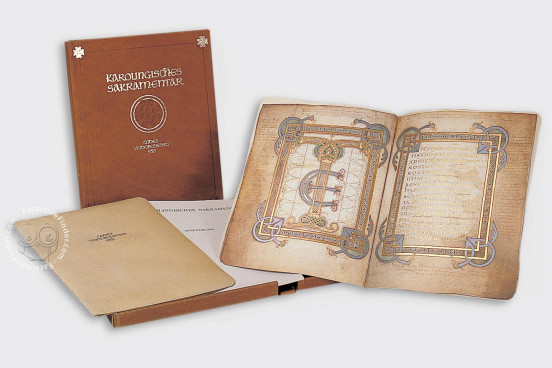The Carolingian Sacramentary is part of the manuscript collection of the Austrian National Library. Its old shelfmark (Theol. C. 992, C. standing for the German word Cimelien (from ancient Greek keimélion, "gem, treasure") enlisted the work among the gems of the collection due to its importance and magnificence. The codex belongs to the French tradition, as it was created at the Abbey of Saint-Amand in northern France. Although the identity of its commissioner remains unknown, the lavishness of the codex leads us to believe that the recipient of the work was likely a high member of the Church.
Liturgical Use of the Carolingian Sacramentary
Due to the lack of major portions of the original sacramentary, this manuscript is often referred to as sacramentary fragment. Fortunately, several elements were preserved, such as the marvellous text of the Canon Missae, and the text for the consecration of a member of the Church, leading us to the idea that this codex served as a support, perhaps for the bishop, which contained prayers and consecration texts for liturgical use.
A Calligraphic Jewel
The Carolingian Sacramentary represent a calligraphic jewel in that it features several scripts executed by several hands. Carolingian Minuscule was identified in the text of the consecration of the sub-deacon and in a section of the Canon, additionally, the Capitalis Rustica script is used for the headings on fol. 1r-v. Finally, the remaining (and major) part of the canon text features solemn Uncials.
The presence of glosses and notes along the margins, together with the use of different scripts, and of neumes annotations (mnemonic device through melody) provide a better understanding of the background of the Carolingian Sacramentary.
Iconographic Apparatus: Anglo-Saxon Motives
Framing the pages of the Canon text are rectangular decorative frames which feature intertwined interlace that follows various patterns, changing from one page to the other. On the contrary, the corner pieces are quite consistent with each other, creating a coherent graphic reference. An example of this decorative feature is to be found in fols. 5v-6r where the interlace between the golden border and the silver bands results into animals' heads.
It is worth noticing the presence of two pages featuring only one detailed and intricate word of text: Vere in fol. 4r and te in fol. 5v. The letters exhibit golden borders and elaborate interlace. Throughout the Carolingian Sacramentary we witness a fusion between Anglo-Saxon decorative motives and Carolingian-Frankish scribal art, which is a combination that can only be found in very few manuscripts and that makes this codex a beautiful and significant example of medieval illumination.
Binding description
Binding
Gold brocade.
We have 1 facsimile edition of the manuscript "Carolingian Sacramentary": Das Karolingische Sakramentar facsimile edition, published by Akademische Druck- u. Verlagsanstalt (ADEVA), 1971
Request Info / Price
